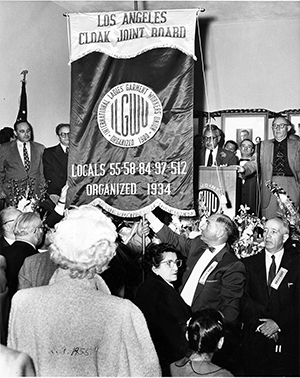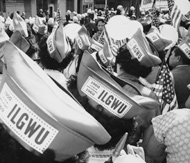

Highlights
The ILGWU Across the USA

The ILGWU in Los Angeles
The first local in Los Angeles was founded in March 1907, and due to its low membership, existed for only three months. Approximately three years later (1910-1911), Local 52 was chartered and by 1920 had changed its name to the Cloak, Suit, Skirt, and Reefer Makers’ Union of Los Angeles to reflect the broad range of manufacturing within the ladies’ garment industry. During the union’s struggle with Communism among the membership in the 1920s, the ILGWU General Executive Board (GEB) revoked Local 52’s charter in November 1928, alleging Communist corruption and planned secession. The Los Angeles union had to be reorganized, and a new Local 65 was formed with former members who had remained loyal to the ILGWU and the GEB. In 1933, Rose Pesotta was sent to Los Angeles to begin a large scale organization drive. During 1933, both Cutters’ Local 84 and Dressmakers’ Local 96 were formed. While the strike in October 1933 was ineffective and gains were limited, the strike did prove the successful organizing of Latina dressmakers. At the beginning of 1934, the Los Angeles Joint Board was formed with representatives of Locals 65, 84 and 96. Early board members included H. Rubinstein (manager), L. Pine (chairman), Axelrod (vice chairman), and Paul Berg (secretary). Later that year, Pressers’ Local 97 was chartered. As union membership increased, the garment workers began making substantial gains during contract negotiations. Advances were made in wages, hours and holidays. The cloak industry became a closed shop and the sector almost 100% unionized. A new local, 236, was chartered in 1936. During this time, the dressmakers underwent another strike, and Isidore Lutsky was the manager of the Joint Board.
In 1940, the Los Angeles Cloak Joint Board separated from the Dress Joint Board. George Wishnak served as the manager of the Dress Joint Board, and Louis Pine managed the Cloak Joint Board from 1941 until his death in 1946. New production in the sportswear industries necessitated the chartering of Local 266 (sportswear and cotton dress workers). By 1947, Los Angeles became the first in the manufacture of sportswear and second to New York in cloak production. Joseph Springer led the Cloak Joint Board from 1946-1950. The Cloak Joint Board was primarily composed of Operators and Finishers Local 65, Cutters Local 65, and Pressers Local 97. The Dress Joint Board was composed of the large Dressmakers’ Local 96 and the cutters and pressers in the dress trade of 84 and 97. These Joint Boards represented much of the skilled workers in the garment industry in Los Angeles, and sights were set on organizing the tens of thousands of unskilled workers. Again, the activities of Communist members within the union began to bring conflict on the west coast, and in 1949, a Special Committee of the ILGWU placed the Cloak Joint Board under the direction of Morris Bagno, and the Dress Joint Board under the supervision of Margaret Di Maggio, to use special powers to remove the remaining Communist influence. In October 1950, Isidore Stenzor took over management of the Cloak Joint Board, a position he would hold until 1970. The ILGWU Health Center for Los Angeles was established in 1951, offering a wide range of service.
The Cloak Joint Board moved to new headquarters in 1955, but the 1950s also saw a shift in production towards sportswear, as membership for Local 266 continued to increase and soon surpass the Operators Local 55 in numbers. In 1955, the ILGWU GEB recommended the merger of the two non-cloak industries, and in September 1955, the Los Angeles Dress and Sportswear Joint Board was created with manager John Ulene. Ulene retired in January 1968 after 50 years of service with the ILGWU. He had been elected head of the Sportswear Joint Council then managed the combined Dress and Sportswear Joint Board from 1955-1968. Sam Schwartz, the director of organizing for the Joint Board, succeeded Ulene as manager for the Dress and Sportswear Joint Board. With decline in membership and a contraction of the union over the next decades, by December 1970, the Los Angeles Dress and Sportswear Joint Board and the Cloak Joint Board merged to form the new Los Angeles Joint Board. Stenzor, who had been manger of the Cloak Board since 1950 resigned, and Cornelius Wall, the Western States Region Director, became the manager for the new Joint Board.
Kathryn Dowgiewicz


